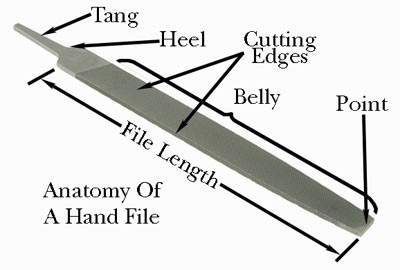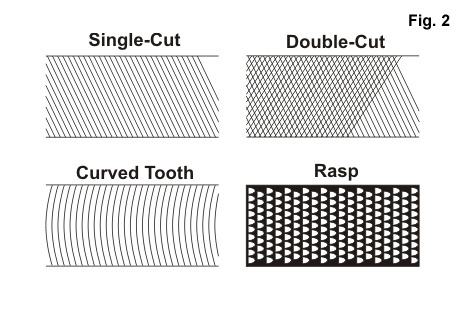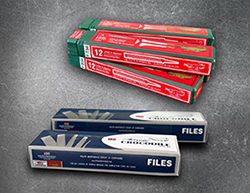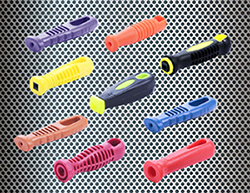Files are cutting tools used to remove and smooth rough and sharp edges from cut metal. They are also used to shape or size metal. For each type of material, there is an ideal tooth form that provides the most efficient cutting action.
Most files are made from high-carbon steel, with the length being hardened and tempered, while the tang is left soft. Files are manufactured in various shapes and sizes. They can be identified by their cross-section, general shape, or specific use. The choice of which file to use depends on the type of work you are doing and the material you are working with. Files are employed for squaring ends, filing rounded corners, removing burrs from metal, straightening uneven edges, filing holes and slots, smoothing rough edges and more.

- Length, (measured without the Tang)
- Cross-section or Shape
- Grade of Cut
Grade of Cut
Files are usually made in two types of cuts, Single Cut and Double Cut. The Single Cut File has a single row of teeth extending across the face at an angle of 65° to 85° for the length of the file. The Double Cut File has two rows of teeth which cross each other. For general work, the angle of the first row is 40° to 45° and the angle of the second row can be anywhere between 30° and 87°.

Files are also classified by the coarseness of the teeth. The bigger the teeth the rougher the feel of the File and the quicker the file will remove material when you are using it. There are three main levels of coarseness that you may come across in the metalwork room and they are :
- Bastard
- Second Cut
- Smooth
If you cannot tell by looking at the File which it is, then just rub your finger gently along it and you should figure it out.

Types of Files
There are many different types of Files, Below you can see a table containing the more common files and their main uses.
| File Name | Description |
|---|---|
| Hand File | The Hand File is parallel in width for its length. It is Double Cut on both faces, Single Cut on one edge, but the other edge is blank and called the Safe Edge. Used for general purposes. |
| Flat File | The Flat File is Double Cut on both faces and Single Cut on the edges. It tapers slightly towards the point. Used for general purposes. |
| Half-Round File | The Half-Round File is Double Cut on the flat side and Single Cut on the curved side. It tapers slightly towards the point in bothe width and thickness. Used for filing concave surfaces and internal corners. |
| Round File | The Round File is Double cut. It tapers slightly towards the point. Used for enlarging holes and internal corners. |
| Square File | The Square File is Double Cut on all sides. It tapers slightly towards the point. Used for rectangular slots, square holes and internal corners. |
| Three Square File | The Three Square File is Double Cut on all sides. It tapers slightly towards the point. It is triangular in section. Used for filing into internal angles. |
Quality of Crocodile Files
- We test our Files performance thru a testing machine that Simulates the Filing process thru a machine. Wherein, the File is Rubbed or made to make the filing operation on a fixed metal strip or a steel bar with hardness close to 45 to 50 HRC.
- What is measured is the number of strokes made by the File on the Job ( steel bar) and the amount of material removed. This Test is Typically known as The Remscheid Test whereby we test the “Rate of Cut “ ( how much material can be removed in the first 1000 strokes second 1000 strokes, third 1000 strokes and so on. This depicts the Aggressiveness of the File. We also check until how many strokes the File stops Filing or cutting the metal. This depicts the life/longevity of the File.
- Through the above tests we always keep tracking the performance of our files regularly.
- We can confirm that our Files have a Unique Blend of Aggregation ( rapid rate of cut in the initial phases ) and Longevity ( it lasts well beyond several 1000 strokes.
Please see our extensive range and packaging options.
- Secured and tight packaging
- Various selections of good quality cardboard and plastic box
- Prevents rusting or any contamination
- Lightweight packaging reduces the transportation cost


Plastic handles are also available.
A well-designed ergonomic range of file handles enables a comfortable grip and ease of handling for all file types.

